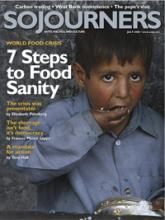The writer of the biblical book of Revelation, commenting on a Roman food crisis, expressed outrage that a day’s wage was not enough to feed a laborer’s family. Part of the problem was that local grain production had been undercut by cheap Egyptian imports and the greater profitability of livestock feed, while the province of Asia saw food staple prices rise because grain was less profitable than wine.
Sound familiar? It should—because the current crisis of world food prices, which has sent 100 million people into poverty, is a mostly human-made disaster.
The problem today is not a lack of food—it’s that it’s too expensive. Many of the world’s poor were already paying up to 80 percent of their income for food; in the last year, rice more than doubled in price, wheat nearly doubled, and corn went up by two-thirds. And the sad truth is that human beings set things up this way.
Here are 10 factors—most of them preventable—that led us to the global food-price crisis we’re in today:
1. Fossil-fuel-intensive farming models. It’s long been obvious that, as our planet’s accessible oil and gas supplies dwindle, their price will go up. Yet for the last several decades, the U.S. and other rich countries have pushed a farming model in which farms are large, heavily mechanized, and geared for export to distant markets. This model ran into the ground many of the small-scale, local farms that had the ability to grow food locally and sustainably (and that, in the global South, had provided some kind of subsistence for former peasants who have now become hungry urban slum dwellers).
Read the Full Article

